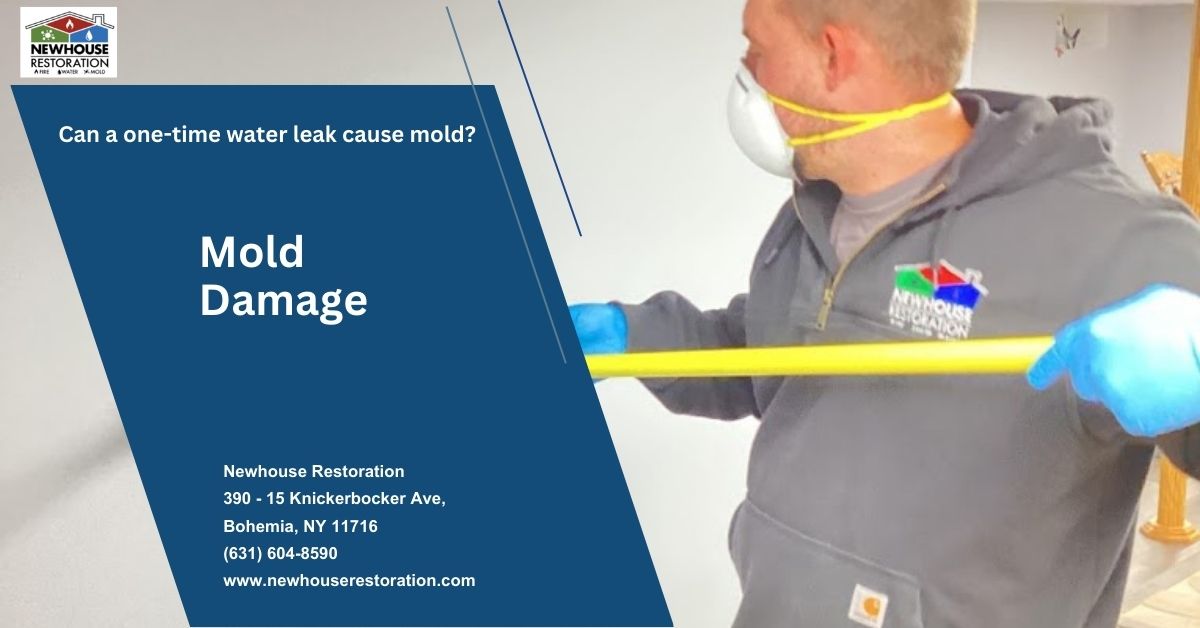Many homeowners assume that mold only develops after prolonged water exposure, such as repeated leaks or floods. However, this is a dangerous misconception. In reality, even a single water leak — if not properly dried and remediated — can lead to mold growth in as little as 24 to 48 hours. Understanding how quickly mold can develop, what signs to look for, and how to respond can save Long Island property owners thousands of dollars in cleanup and repairs.
Why Even One Leak Can Lead to Mold
Mold spores are microscopic and exist naturally in nearly every environment, including inside your home. These spores are generally harmless until they encounter excess moisture, which acts as a trigger for growth. Once moisture is present and not quickly removed, mold can begin colonizing porous materials like drywall, insulation, carpet, wood, and even furniture.
The critical conditions for mold to grow are:
-
Moisture (from leaks, spills, humidity, etc.)
-
Organic material (like wood, drywall, or paper)
-
Time (as little as 24–48 hours)
That means a single incident — such as a burst pipe, a sink overflow, or a heavy rainstorm that leaks through a window — can create the ideal environment for mold to take hold if it’s not handled properly.
Hidden Moisture: The Silent Threat
The most dangerous aspect of water damage is often what can’t be seen. Water may appear to have dried on the surface, but it can linger inside walls, under flooring, or behind cabinetry. This hidden moisture allows mold to grow unchecked for days or even weeks before it’s discovered.
Examples of hidden moisture sources include:
-
Soaked insulation behind drywall
-
Damp subfloors beneath hardwood or laminate
-
Wet carpet padding after a spill
-
Moisture trapped behind baseboards or under appliances
Professional moisture meters and infrared cameras can detect what the naked eye cannot — which is why a proper inspection is so important after any water event, even a minor one.
How Mold Impacts Your Home and Health
Mold isn’t just a cosmetic issue. If left untreated, it can cause serious structural and health problems, including:
-
Wood rot and structural deterioration
-
Staining and damage to walls, ceilings, and floors
-
Musty odors that linger and are difficult to eliminate
-
Respiratory problems, allergy symptoms, or asthma flare-ups
-
Increased risk of illness, especially for infants, elderly residents, or those with compromised immune systems
The longer mold is allowed to grow, the more extensive — and expensive — the remediation process becomes.
Signs That Mold May Be Developing
Even if you’re not sure whether your one-time water incident caused mold, stay alert for these warning signs:
-
Persistent musty smell, especially in closed areas like closets, basements, or behind furniture
-
Discoloration on walls or ceilings (gray, black, green, or brown spots)
-
Peeling paint or bubbling drywall
-
Warped floors or soft spots in flooring
-
An increase in allergy symptoms, such as sneezing, coughing, or itchy eyes — especially in one part of the home
If any of these symptoms are present, especially in the days or weeks following a water incident, it’s time to investigate further.
Steps to Take After a One-Time Leak
Responding quickly to water damage is key to avoiding mold. Here’s what to do if you’ve experienced a water leak:
✅ Immediate Action
-
Stop the water source (shut off water supply if needed)
-
Remove standing water with mops, towels, or a wet/dry vacuum
-
Ventilate the area with fans and open windows (if weather permits)
-
Move furniture and belongings away from the wet zone
🛠️ Professional Intervention
-
Call a certified water damage restoration company within 24 hours
-
Request a moisture inspection to identify hidden wet areas
-
Begin professional drying using dehumidifiers and air movers
-
Remove water-damaged materials if they can’t be salvaged (e.g., drywall, carpet padding)
🧼 Mold Prevention
-
Ensure complete drying within 48 hours
-
Apply antimicrobial treatments to affected surfaces
-
Monitor for signs of mold over the next few weeks
-
Consider a post-dry-out inspection to confirm moisture levels are safe
When to Call a Professional
While small spills may be manageable, any leak that affects structural components of your home (like walls, floors, or ceilings) warrants a call to a professional restoration company. They have the tools, training, and experience to dry and restore your property properly — and to catch early signs of mold before it becomes a major problem.
Even if mold has already developed, acting quickly can keep the problem contained and avoid further damage.
Final Thoughts: Don’t Underestimate One-Time Leaks
One water event may not seem like a big deal — until weeks later, when musty odors or discoloration begin to appear. The truth is, mold doesn’t care how big the leak was or how long it lasted. All it needs is moisture, material, and time.
By taking swift action, contacting professionals when needed, and ensuring complete dry-out, homeowners can avoid mold damage and protect their property and health.


